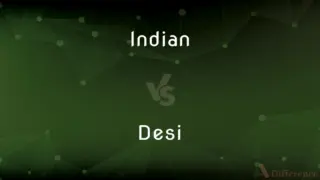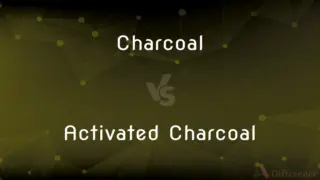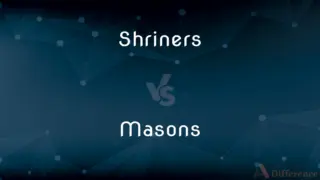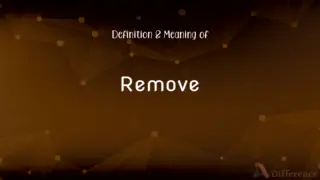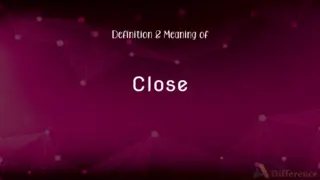Sequence vs. Chronological Order — What's the Difference?
By Maham Liaqat & Fiza Rafique — Published on March 10, 2024
Sequence involves a specific order or arrangement, not necessarily based on time, while chronological order strictly follows a timeline.
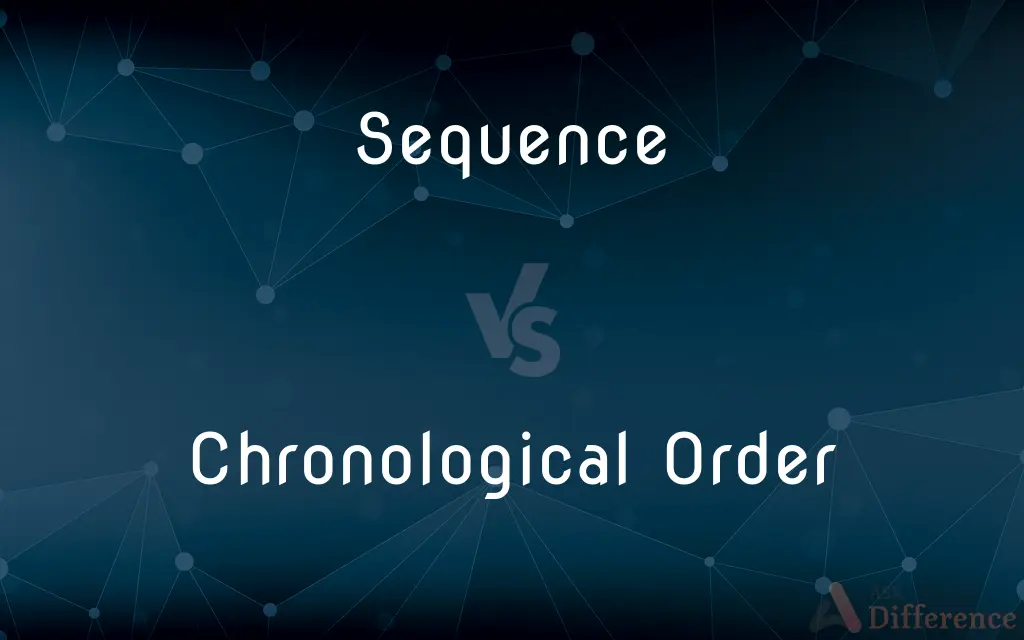
Difference Between Sequence and Chronological Order
Table of Contents
ADVERTISEMENT
Key Differences
Sequence refers to the order in which events, processes, or items are arranged, allowing for various organizing principles such as importance, function, or category. Whereas, chronological order is a type of sequence that specifically arranges events or items based on their time of occurrence, strictly adhering to a timeline from earliest to latest.
In sequencing, the focus is on the logical or functional arrangement, making it applicable in contexts like instructions or categorization, where time may not be a relevant factor. On the other hand, chronological order is primarily used in historical narratives, timelines, and any documentation where the progression of time is crucial to understanding the sequence of events.
Sequence can also imply a pattern or a recurring order, where elements follow a certain rule or arrangement, not limited by temporal constraints. Whereas chronological order is linear and time-bound, ensuring that each event is placed in relation to its actual time of occurrence, without any repetition unless it marks a specific recurrence of an event.
The flexibility of sequence allows it to be used in abstract concepts, such as mathematical sequences where numbers follow a specific pattern, or in storytelling where events might be arranged for thematic or dramatic effect. Chronological order, by its nature, does not allow for such flexibility, as it is bound by the linear progression of time.
Understanding sequence is crucial for grasping the structure of various systems or narratives, allowing for an understanding that is not confined to the temporal aspect. Whereas, chronological order provides a clear temporal framework that is essential for understanding historical events, developments, and causal relationships in a time-sensitive context.
ADVERTISEMENT
Comparison Chart
Definition
Order of arrangement, not necessarily time-based.
Order based on time sequence, from earliest to latest.
Key Focus
Logical or functional arrangement.
Time progression and historical accuracy.
Flexibility
Can include various organizing principles.
Strictly adheres to the timeline.
Applicability
Broad, including instructions, categorization, and storytelling.
Primarily historical narratives, timelines, and documentation.
Temporal Constraint
Not necessarily time-bound.
Always time-bound.
Compare with Definitions
Sequence
The arrangement of events in a story, which may not follow a chronological order.
Some novels use a non-linear sequence of events to build suspense or develop characters.
Chronological Order
Using time order in storytelling to maintain a linear progression of the narrative.
The novel unfolds in chronological order, giving readers a clear sense of time progression.
Sequence
A series of steps or instructions arranged to achieve a specific goal or result.
The sequence of operations in emergency procedures is crucial for safety.
Chronological Order
A linear representation of important events in the order in which they occurred.
The museum's timeline of ancient civilizations displays cultures in chronological order.
Sequence
The arrangement or order of elements or events in a particular order, not necessarily related to time.
The sequence of colors in a rainbow is always the same, which is red, orange, yellow, green, blue, indigo, and violet.
Chronological Order
Presenting historical events in the order they occurred to preserve accuracy and context.
The documentary presents the events of World War II in strict chronological order.
Sequence
Identifying a recurring order or pattern within a set of items or events.
The Fibonacci sequence starts with 0 and 1, and each subsequent number is the sum of the previous two.
Chronological Order
The arrangement of events or items in the order of their occurrence in time, from earliest to latest.
The biography was written in chronological order, detailing the subject's life from birth to death.
Sequence
An ordered set of numbers that follow a particular rule or pattern.
In a geometric sequence, each term is found by multiplying the previous term by a constant.
Chronological Order
Organizing documents or evidence based on the time of creation or occurrence.
The court documents were submitted in chronological order to maintain a clear timeline of events.
Sequence
A following of one thing after another; succession.
Sequence
An order of succession; an arrangement.
Sequence
A related or continuous series.
Sequence
(Games) Three or more playing cards in consecutive order and usually the same suit; a run.
Sequence
A series of related shots that constitute a complete unit of action in a movie.
Sequence
(Music) A melodic or harmonic pattern successively repeated at different pitches with or without a key change.
Sequence
Roman Catholic Church A hymn sung between the gradual and the Gospel.
Sequence
(Mathematics) An ordered set of quantities, as x, 2x2, 3x3, 4x4.
Sequence
(Biochemistry) The order of constituents in a polymer, especially the order of nucleotides in a nucleic acid or of the amino acids in a protein.
Sequence
To organize or arrange in a sequence.
Sequence
To determine the order of constituents in (a polymer, such as a nucleic acid or protein molecule).
Sequence
A set of things next to each other in a set order; a series
Sequence
(uncountable) The state of being sequent or following; order of succession.
Complete the listed tasks in sequence.
Sequence
A series of musical phrases where a theme or melody is repeated, with some change each time, such as in pitch or length (example: opening of Beethoven's Fifth Symphony).
Sequence
A musical composition used in some Catholic Masses between the readings. The most famous sequence is the Dies Irae (Day of Wrath) formerly used in funeral services.
Sequence
(mathematics) An ordered list of objects, typically indexed with natural numbers.
Sequence
A subsequent event; a consequence or result.
Sequence
A series of shots that depict a single action or style in a film, television show etc.
Sequence
(card games) A meld consisting of three or more cards of successive ranks in the same suit, such as the four, five and six of hearts.
Sequence
(transitive) to arrange in an order
Sequence
To determine the order of things, especially of amino acids in a protein, or of bases in a nucleic acid
Sequence
(transitive) to produce (music) with a sequencer
Sequence
The state of being sequent; succession; order of following; arrangement.
How art thou a kingBut by fair sequence and succession?
Sequence and series of the seasons of the year.
Sequence
That which follows or succeeds as an effect; sequel; consequence; result.
The inevitable sequences of sin and punishment.
Sequence
Simple succession, or the coming after in time, without asserting or implying causative energy; as, the reactions of chemical agents may be conceived as merely invariable sequences.
Sequence
Any succession of chords (or harmonic phrase) rising or falling by the regular diatonic degrees in the same scale; a succession of similar harmonic steps.
Sequence
A hymn introduced in the Mass on certain festival days, and recited or sung immediately before the gospel, and after the gradual or introit, whence the name.
Originally the sequence was called a Prose, because its early form was rhythmical prose.
Sequence
Three or more cards of the same suit in immediately consecutive order of value; as, ace, king, and queen; or knave, ten, nine, and eight.
Sequence
The specific order of any linear arrangement of items; as, the sequence of amino acid residues in a protein; the sequence of instructions in a computer program; the sequence of acts in a variety show.
Sequence
To determine the sequence of; as, to sequence a protein or a DNA fragment.
Sequence
Serial arrangement in which things follow in logical order or a recurrent pattern;
The sequence of names was alphabetical
He invented a technique to determine the sequence of base pairs in DNA
Sequence
A following of one thing after another in time;
The doctor saw a sequence of patients
Sequence
Film consisting of a succession of related shots that develop a given subject in a movie
Sequence
The action of following in order;
He played the trumps in sequence
Sequence
Several repetitions of a melodic phrase in different keys
Sequence
Arrange in a sequence
Sequence
Determine the order of constituents in;
They sequenced the human genome
Common Curiosities
Can a sequence be chronological?
Yes, a sequence can be chronological if it arranges events or items based on their time of occurrence.
Are all sequences time-based?
No, sequences can be based on various organizing principles, not just time.
Is chronological order always linear?
Yes, chronological order is linear, arranging events from the earliest to the latest in a straight line of progression.
What is the main difference between sequence and chronological order?
Sequence refers to any specific order of elements or events, while chronological order is a sequence based on time progression.
Can sequence apply to abstract concepts?
Yes, sequence can apply to abstract concepts, such as mathematical sequences or thematic arrangements in storytelling.
What role does sequence play in instructional contexts?
Sequence organizes steps or instructions to achieve clarity and efficiency in reaching a specific goal.
Why is chronological order important in legal documents?
It ensures a clear and accurate timeline of events, crucial for legal proceedings and evidence presentation.
How does chronological order aid in understanding history?
It provides a clear timeline of events, helping to understand historical developments and causal relationships.
Can a narrative structure be non-chronological?
Yes, narratives can use non-chronological sequences to achieve certain effects, like suspense or character development.
Can sequence influence the outcome of a process?
Yes, the order of steps in a sequence can significantly impact the efficiency and outcome of a process.
How does chronological order differ in storytelling?
In storytelling, chronological order maintains a linear time progression, which can enhance clarity and realism.
Is it possible to have a sequence within a chronological narrative?
Yes, a chronological narrative can include sequences of events that follow a specific pattern or order within the overall timeline.
How does the flexibility of sequence compare to chronological order?
Sequence is more flexible, allowing various organizing principles, while chronological order is strictly time-bound.
Does chronological order affect the interpretation of historical events?
Yes, presenting events in chronological order can influence their context and perceived significance.
How do mathematicians use sequences?
Mathematicians study sequences to understand patterns, solve problems, and explore mathematical concepts.
Share Your Discovery

Previous Comparison
CR2032 vs. CR2016
Next Comparison
Dungeness Crab vs. Snow CrabAuthor Spotlight
Written by
Maham LiaqatCo-written by
Fiza RafiqueFiza Rafique is a skilled content writer at AskDifference.com, where she meticulously refines and enhances written pieces. Drawing from her vast editorial expertise, Fiza ensures clarity, accuracy, and precision in every article. Passionate about language, she continually seeks to elevate the quality of content for readers worldwide.











